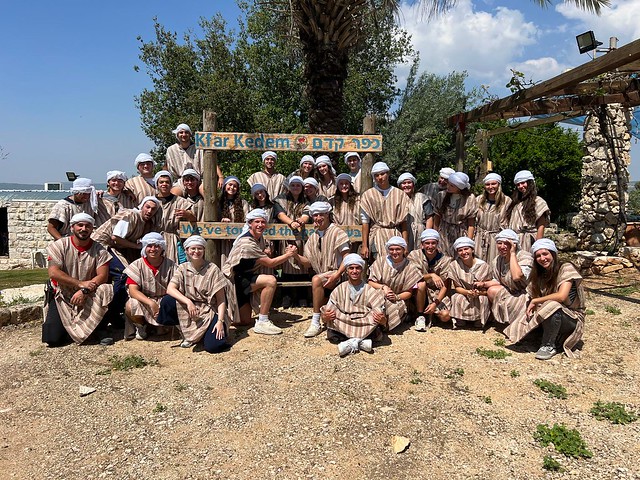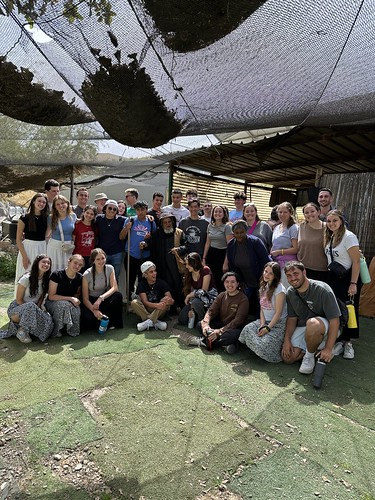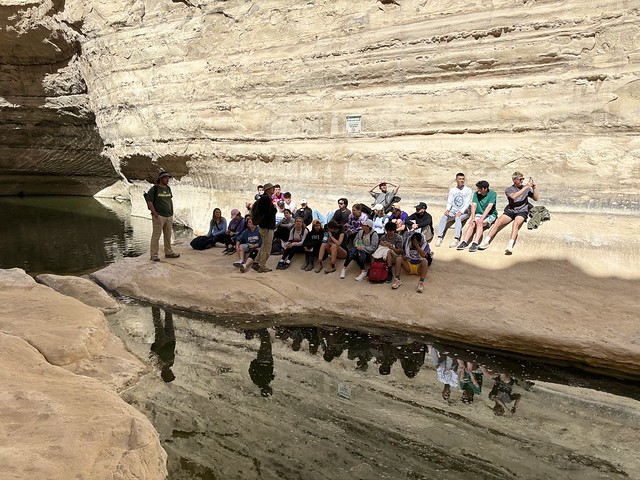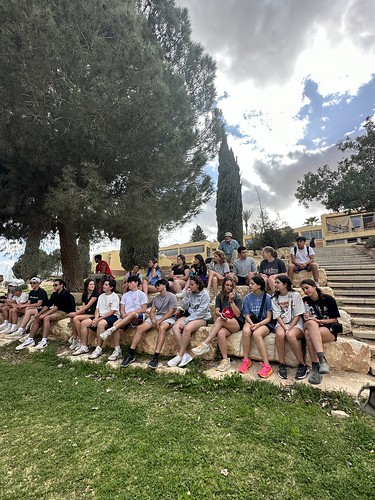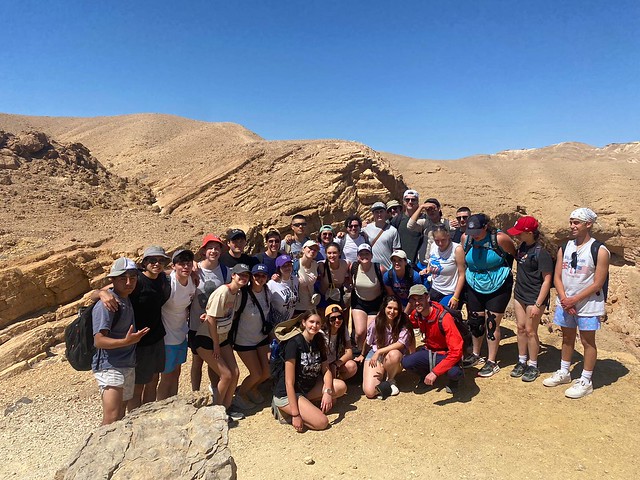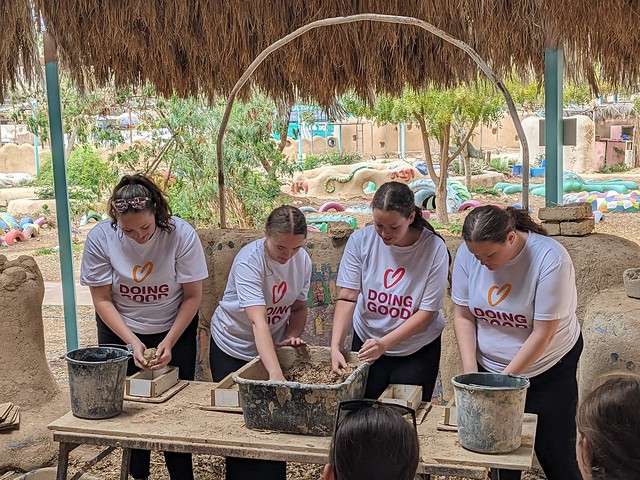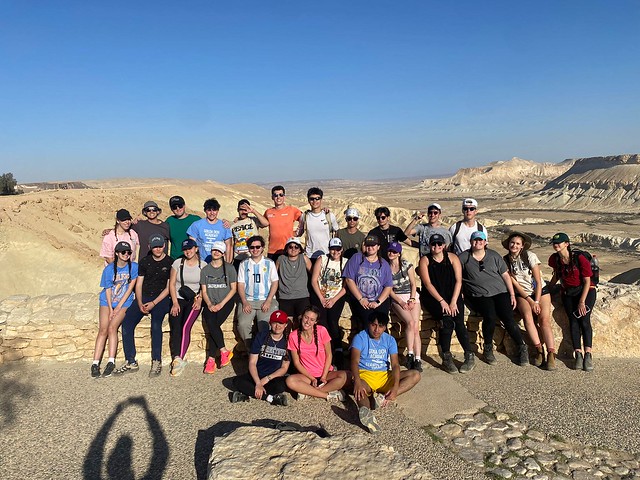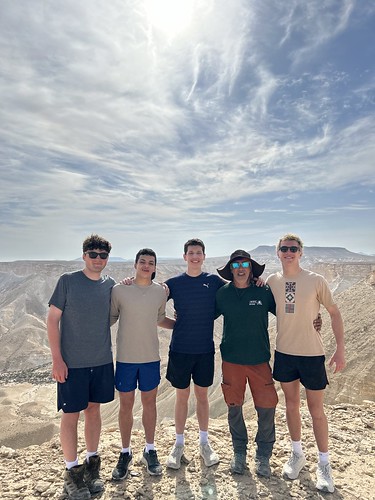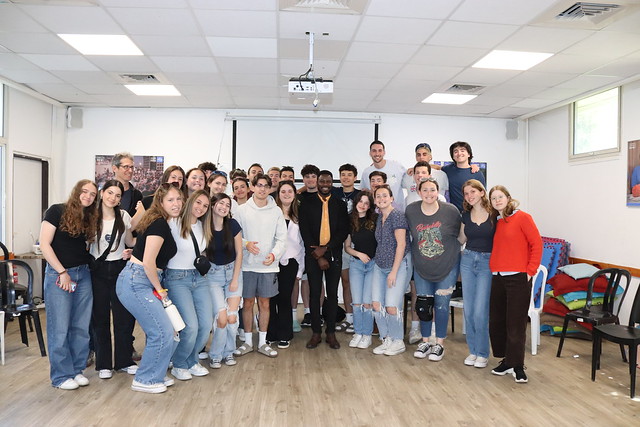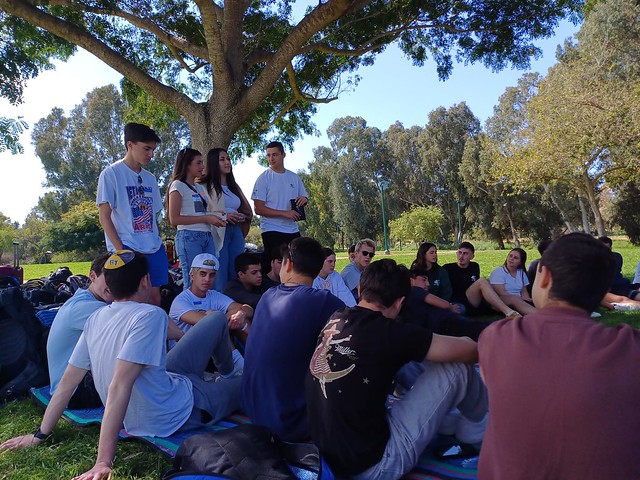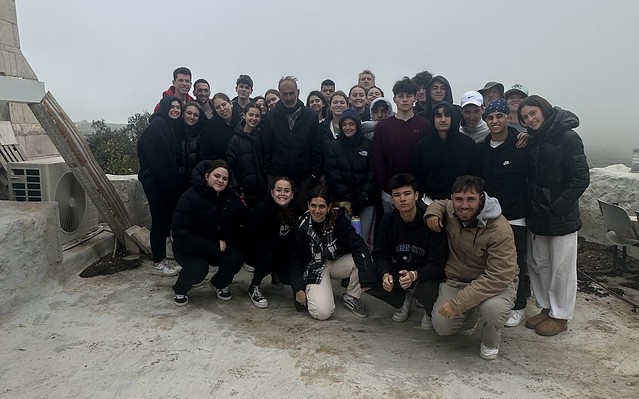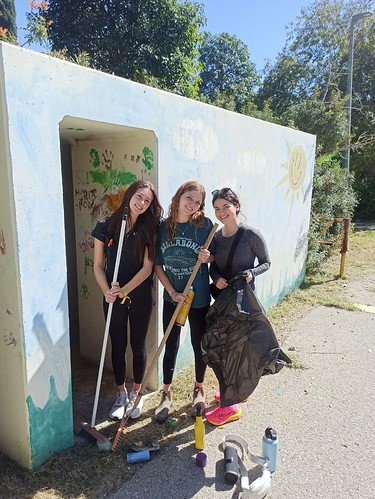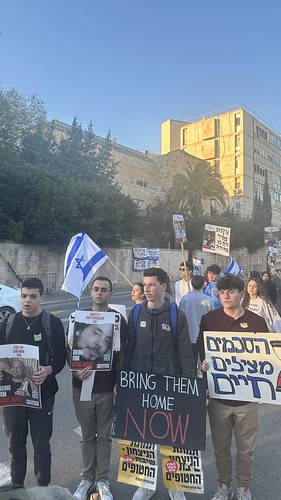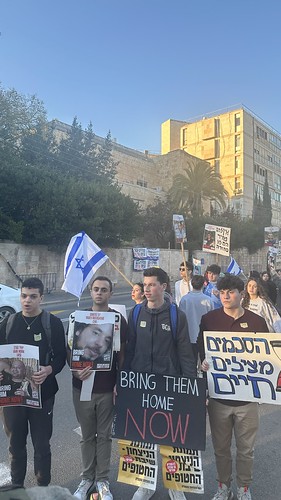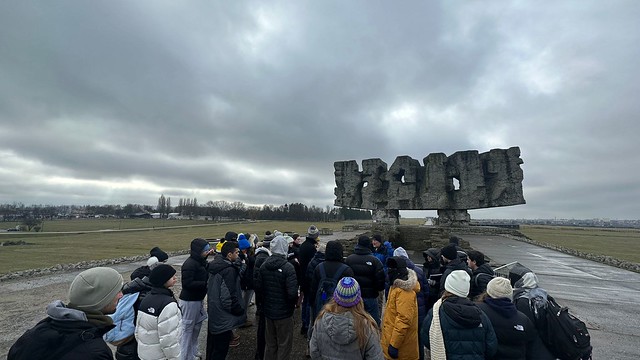Programs
Israel Education
Neshama 32
Trip Blog
List of 37 items.
-
Wednesday, April 16
Adina:Bright and early Wednesday morning, after a hearty breakfast, we packed the bus and headed for an adventure to Tzfat.Upon arriving, we walked towards a viewpoint near a crusader fortress and engaged in a lively debate about the meaning of life. Opinions varied, with some advocating for carpe diem, others believing we are all on Earth for a purpose and need to fulfill it, and some simply aiming to go to bed happy every day. Many of us believed in a combination of these ideas.Next, we ventured into a well and sang אחינו, טוב להודות, עוזי, and ומה טובו. As we left the well, we sang Lecha Dodi to commemorate the history of the song, which was written in Tzfat.We then descended into a crusader fortress to learn about the history of Tzfat, which has been fought over by the British, Arabs, and Israelis. Continuing our tour, we visited a synagogue to learn about the Ari and his philosophy on life.After a pizur lunch, we headed to the synagogue named after Yosef Karo, where the door is on the same wall as the ארון הקודש. We recalled a connection to the Rama synagogue in Poland that we visited, noting that Rama wanted to put his own version of the Shulchan Aruch but waited to combine his opinions (mapa) with Yosef Karo.Our afternoon included a Jewish meditation session that integrated music and instruments, teaching us how the four elements of our lives relate to music and how they can be incorporated into meditation.We then had a few minutes to shop in the old city of Tzfat, where we all ended up craving a refreshing drink, which we enjoyed at a charming little bakery.Next, we hopped on the bus and made our way to Tiberias for more shopping and a sweet treat, which Neshama loves. Due to some stores in Tzfat not opening to tourists because of the events on October 7th, Rob and the madrichim decided to make an additional stop in Tiberias, making the most of our trip.Finally, we returned to Deganya Bet to rest a bit before enjoying a delicious dinner. We ended our night with an amazing zman mishpacha led by a student in each mishpacha.Toda, Thursday, we started our day with a 7:45 breakfast, then headed off to our first hike in the north at Yehudiya National Park.We arrived at the park and began our hike, walking for a pleasant hour or so until we reached a refreshing spring where we took a break and cooled off. We then continued the descent to another pool of water to relax. The descent was challenging, but the reward of jumping into the cool water was worth it. After spending time in the spring, we ascended back to the bus.Once on the bus, we grabbed a quick sweet treat before heading off to Hatzer haKineret. This site narrates the history of modern Zionism pioneers during the first and second Aliyah.Afterward, since Neshama 32 can't get enough of water, we ended up visiting a beach on the Kinneret, which was very relaxing.Finally, we returned to Deganya Bet for some free time before dinner.As a special treat after dinner, we had a visit from alumni, Hannah Lancman, to hear her story of making Aliyah and joining the army as a lone soldier. It was fascinating to hear how her time on Neshama inspired her decision to live in Israel.Well, that’s it for now on Neshama 32!Peace out! Good night! -
Tuesday, April 15
Yuval:Returning from a rejuvenating yet somewhat stressful weekend, Neshama headed south to Ketura for the second time. After relaxing and catching some sleep on the bus, our group took time to process and debrief the highs and lows of our weekend. Following this activity, breakout discussion groups convened, and Vaad Neshama unveiled our plan for the next day: Maccabiah!The first Maccabiah competition kicked off after dinner, offering each team the chance to earn points based on spirit and efficiency while helping to make the Ketura kitchen kosher for Passover.With a late start awarded to us, Neshama was eager to dive into the competitions. First up was a trivia contest about our grade and Neshama personnel. Next came the most anticipated sport of the competition: basketball. In a thrilling championship game, the white team narrowly defeated the black team, thanks in part to Joe Askin's facilitation—Golda Och Academy Roadrunners’ best.The afternoon was action-packed with soccer, pool breaks, and beach volleyball. As the day's competitions concluded, victory was still up for grabs. To wrap up Maccabiah, we held a shesh besh (backgammon) tournament during dinner, with each team sending a representative. Unfortunately, due to some individuals needing to leave for their kitchen cleaning shift, the tournament was declared a no contest. In the end, "the black queens" emerged victorious, conquering the first annual Och Olympics.Until next time! -
Wednesday, April 10
Noah:We're finally back in Tel Aviv! We kicked off our stay by dropping our belongings at the hostel and then heading to the beach for some wave jumping, tanning, and, of course, grabbing some Aroma. After a 40-minute walk back from the beach, we ended our night with dinner and headed to bed.The next day, we explored the streets of Tel Aviv on a graffiti tour, encountering many new pieces created after October 7th. These works shared the stories of individuals who risked their lives to save others. After the tour, we visited Florentine, a charming area filled with stores and restaurants, where many of us enjoyed burgers and wings (the wings were REALLY good). After a satisfying lunch, we returned to the hostel to relax and have dinner before heading to a concert by Ravid Plotnik, which was very סבבה (THANK YOU, JONAS - Ravid is Jonas' cousin!). We had an amazing time, especially when he gave us a shout-out and even took a picture with us afterward. It was a fantastic way to wrap up the day.To conclude our short trip in Tel Aviv, we participated in a culinary workshop where we learned to make pasta, salad, pizza, polenta, and risotto, all from scratch. After cooking, we set the table and enjoyed one of the best lunches of our Neshama experience. Once we finished our delicious meal, we took some time to digest before heading to the bike store, where some of us embarked on a 10-mile bike ride, while others opted for yoga. We had so much fun, regardless of the activity, and now we're setting off for a fantastic free weekend! -
Monday, April 8
Mimi:On Sunday morning, we visited Maresha National Park to participate in the “Dig for a Day” volunteering project. This initiative recruits students and other groups to excavate nearly 2,000-year-old caves, aiding archaeologists in uncovering the society that once inhabited this area. Our grade was split into two groups, each exploring a different cave room. Armed with a dirt bucket, a bucket for finds, a pickaxe, and an optional shovel (though most of us used our hands), I tackled a patch of dirt. After loosening the dirt with the pickaxe, I sifted through it by hand for charcoal pieces, pottery shards, bones, or pieces of metal or glass, then disposed of the leftover dirt and chalk rock into a bucket. Yuval discovered a glass idol, and Giselle and Rebecca found the top of a clay jug. Unfortunately, I didn’t find anything while digging. However, after exiting the cave and sifting through the buckets of leftover dirt and rock, I found several pottery shards and shells.Next, we crawled through more caves that served various purposes for this ancient society, from silos to pigeon coops. After a quick pre-packed lunch, we visited a nearby Kibbutz called Beit Guvrin, where we had the unique opportunity to clean artifacts found in the caves. Our grade divided into smaller groups, each handling a crate of artifacts. We soaked and scrubbed them to reveal their colors and patterns.Then, we headed to Notre Dame, a Vatican-funded hotel for Christians on a pilgrimage to Jerusalem. From the rooftop, we enjoyed a beautiful view of Jerusalem and sang some of our favorite spiritual songs.That night, some of us attended a large rally at the Knesset demanding the return of all 133 hostages in Gaza. Witnessing the unity of around 80,000 Israelis rallying for a single cause was incredibly powerful.On monday we started our day at Yad L’Kashish, a center where elderly people living below the poverty line create art, providing them with social interaction, a sense of purpose, and a financial stipend. We visited the gift shop, which housed beautiful pieces crafted by these artists.Next, we visited Ammunition Hill, a museum that audio-visually narrates the story of the Six-Day War, focusing on the Jerusalem front. Each Neshamanik received a headset and phone to explore the museum at their own pace.For lunch, we went to the First Station, an outdoor dining and shopping area built on Jerusalem’s old train station, where I enjoyed delicious gnocchi with rosa sauce. Neshamaniks had the option to stay and shop or walk back to Agron.Later, the CEO of Women of the Wall explained the group’s goals and the progress made in negotiations with the Orthodox rabbinate.That night, after dinner, the counselors organized a fun game show modeled after the popular Israeli TV show “הכל הולך,” reinvigorating our group's energy.Finally, early this morning, we joined Women of the Wall for Shacharit. Standing with women of all nationalities and ages for a common goal was incredibly powerful. Despite heckling, we continued the service. Eliana, Avital, Talia, and I took an Aliya to the Torah, which felt very meaningful and connected me further to the cause.Bye for now, Jerusalem!! -
Tuesday, April 2 - Wednesday, April 3
Giselle:Tuesday morning, we woke up in Kibbutz Almog and headed to Ein Gedi after our initial hike was closed. After quickly resolving that issue, we started our long and challenging ascent. Once we reached the top, Rob taught us about the Chalcolithic people and their attraction to that seemingly random mountain in the middle of the desert. The unlikely springs of fresh water carry water that rained in Jerusalem 500 years ago! It's extremely fascinating to learn that the water we swam in just two days ago began its cycle centuries ago. We also delved into the meaning of “awe” and what it means to us. We then descended the lovers' cave, where we enjoyed the refreshing pools of natural water we had just learned about. We concluded our Ein Gedi hike with a sweet treat! Next, we boarded the bus that took us to the Ein Gedi Synagogue, where we prayed Mincha and were joined by a religious girls' school while singing "Acheinu." Our final stop of the day was the Jordan River, where the Jews crossed into Eretz Yisrael centuries ago. Later that night, we bonded with our peers in a group activity led by our madrichim.On Wednesday, our day started off similarly to Tuesday, as Ein Prat was closed. Rob quickly switched our schedule, and we made our way to Jerusalem to hike in King David's tunnels. We guided one another through the pitch-black, narrow halls of Hezekiah's tunnels. Although it was a bit challenging, considering I did it barefoot with many of my peers, it was definitely a highlight of Neshama so far! We then stopped at D City for a quick break before heading back to Kibbutz Almog. The madrichim created a bonfire to conclude our night, where we sang songs to Kenny's spectacular guitar playing. These past two days were so exciting as we pushed our comfort zones and accomplished difficult hikes. We can't wait for the coming weeks! -
Sunday, March 26
Maya:On Sunday, we returned from a rejuvenating free weekend, ready to continue our journey in Israel. Our day resumed with a visit to the Dimona Mall, where we savored a delightful pizzur lunch. It was my birthday, so everyone sang "Happy Birthday" to me and presented me with a cake! We then met with the African Hebrew Israelites, where we engaged in an informative session about their culture and history, as well as some dancing related to their African-Israeli culture. Following this, we drove to Kfar HaNokdim, located in the Judean desert, where we participated in a Bedouin experience, sleeping in large tents, building bonfires, and riding camels. Camel riding was a new and exhilarating experience that most of us thoroughly enjoyed. As the sun set, we gathered for an insightful session recounting the battle of Masada. This prepared us for our hike up Masada the next morning.Bright and early at 4:00 am, we headed to Masada. We ascended the Roman ramp, which consisted only of stairs, and reached the top just as the sun was rising. We relaxed at the top, enjoying the view, before embarking on a tour of Masada. Following the tour, we descended from the mountain, some taking the snake path and others opting for the lift to the bottom, where we all enjoyed a nice breakfast. Our journey then led us to a beautiful Dead Sea hotel, where we indulged in a peaceful and relaxing morning and afternoon. We swam in the pool, enjoyed the spa amenities, took naps, and of course, relished the skin-enhancing benefits of the Dead Sea. After a blissful rest, we gathered for Mincha in the hotel's Beit Knesset. We then made our way to Kibbutz Almog, where we enjoyed a tasty dinner before retiring early, eager to embrace the adventures awaiting us the next day.These past two days have been some of the most enjoyable days of the trip so far. I had the most interesting and peculiar birthday ever, riding camels in the desert and sleeping on mattresses head to head. I particularly enjoyed Monday's activities, spending time relaxing in the pool with friends, reading my book on the beach, and enjoying naps under the sun. I feel incredibly rejuvenated after these past few days. Our visit with the African Hebrew Israelites deepened my connection with Israeli-Jewish culture and fostered new connections with other cultural groups. As I think about the adventures ahead and reminisce about past experiences, I hope my friends and I enjoy every minute this program has to offer. -
Monday, March 25
Yehonatan:Wednesday offered a captivating blend of cultural immersion and agricultural insight. Our journey began with a visit to the Bedouin village of Rahat, where we delved deep into the heart of Bedouin culture. From learning about their nomadic traditions to experiencing their warm hospitality, each moment was infused with a profound sense of connection to this ancient way of life.Next, our exploration took us to the Salad Trail, where we embarked on a fascinating journey into the world of agriculture under extraordinary circumstances. As we traversed the fields, we gained firsthand knowledge of the challenges faced by farmers living in regions prone to conflict. Despite the ever-present threat of rocket fire, these resilient individuals persevere, cultivating crops amidst adversity, embodying the spirit of resilience and fortitude.On Thursday we volunteered at a strawberry farm in Moshav Qadima-Zoran to support local farmers facing a shortage of foreign workers due to the ongoing war in Israel. Despite the scorching heat, the experience was immensely gratifying as we worked alongside the community, picking strawberries and contributing to their harvest.Following our farming efforts, we enjoyed a relaxing pizzur lunch to unwind before heading to Save a Child's Heart (SACH). SACH is a renowned Israeli nonprofit organization dedicated to providing life-saving cardiac care to children from developing countries. Founded in 1995 by Dr. Ami Cohen, an Israeli pediatric heart surgeon, and supported by a team of medical professionals, SACH's mission is to offer high-quality, cost-free cardiac treatment to children suffering from congenital and rheumatic heart diseases.The organization operates primarily at the Wolfson Medical Center in Holon, Israel, where it conducts complex pediatric cardiac surgeries, interventions, and post-operative care. SACH also conducts medical missions to countries around the world, providing training and expertise to local medical teams and identifying children in need of treatment. After learning about the organization, we spent time with children from Africa who are awaiting life-saving heart surgeries, bringing joy and companionship to their usually mundane schedules before heading out for our free weekends. -
Sunday, March 24
Peri:Sunday marked the beginning of our Purim journey. We had a full day ahead to get ready for Purim in Israel. After breakfast, we walked the short distance to the Beit Knesset in the Agron Hostel to pray Shaharit. Afterwards, each mishpachah met to put the final touches on their costumes and their part of the Purim spiel. Then came the exciting part: as a group, Neshama walked downtown to buy props and costumes needed for their roles, with only 150 shekels to spend. I’m sure you’re eager to know what Neshama 32 dressed up as, but you’ll have to wait a bit longer. All the shopping made us seniors hungry, so we headed straight to Shuk Machane Yehuda for a pizzur lunch. There, the seniors picked out gifts for another senior for Gamad v’Anak (similar to Secret Santa). After eating and purchasing gifts and costumes, we returned to Agron to prepare for the festivities. Mishloach Manot were prepared for the nursing home we planned to visit on Monday, and Fuchsberg was decorated for the Purim dinner and spiel.Now for the costumes: Yuval’s mishpachah dressed as characters from The Wizard of Oz, Bar’s mishpachah as characters from Inside Out, Siso’s mishpachah as garden fairies, and Aya’s mishpachah as Cruella’s Dalmatians, with Aya as Cruella. Once in costumes, we set out for the Megillah reading in Arnona. Returning from the Megillah reading, we enjoyed many activities programmed by Mimi and Yehonatan, including performing the Purim spiel, playing Kahoot, exchanging Gamad v’Anak gifts, playing Family Feud, dancing, and singing. It was touching to see the meaningful gifts exchanged among one another. The winning mishpachah was Aya’s, earning the prize of dressing up Rob in whatever the members desired. After a long night, it was time for bed before the next day’s Purim activities.Monday morning, we donned our glorious costumes again and visited a nursing home in Jerusalem. There, we played with balloons, sang songs, distributed Mishloach Manot, and read part of the Megillah. Seeing everyone join in the Purim celebration was heartwarming. Afterwards, we returned to Agron to change into warmer clothes due to the unpredictable weather, then headed to the streets of Jerusalem to watch the Purim parade, which featured creative floats, costumes, and dances. Notably, the parade included the families of hostages, holding up a banner and displaying many yellow ribbons to remind us of the children being held hostage. The parade was followed by lunch on Ben Yehuda Street.Back at Agron before dinner, we had a meaningful discussion about celebrating Purim during a time of war, discussing what is appropriate. A prevailing sentiment, which I share, is that while holidays are times of celebration, they also remind us of our resilience as a nation. Despite the backdrop of conflict, the parade was a testament to joy and unity, essential for the country’s spirit. Even as we celebrated, the hostages remained in our thoughts.After dinner, we had a collective Zman Mishpachah, encouraging open and honest conversations with someone we might not usually talk to. It was a moment when no one wanted their conversations to end, but rather to continue and deepen.Purim was a blend of joy—filled with happiness, singing, dancing, and playfulness—and a time of reflection for those who could not celebrate with us. -
Saturday, March 23
Avi:The luxury of sleeping in until 12:30 allowed us to catch up on much-needed rest. Gathering together, we listened to Andrew's insightful Dvar Torah, reflecting on our journey and the significance of the parsha in connection to Neshama. Following the dvar, we had lunch.In the afternoon, we embarked on a scavenger hunt around Agron. Hints led us to nostalgic sites, recalling memories and laughter. Later, we engaged in a lively "guess who" game, with answers from a Google form read aloud. Each mishpachah had to deduce who each statement described. A friendly competition filled the room. A well-deserved couple of hours of free time allowed us to unwind. As the sun set, we gathered for Havdalah, bidding farewell to Shabbat. The day concluded with a pizzur dinner at Ben Yehuda Street. With hearts full and memories made, we settled in for a peaceful night's rest. -
Friday, March 22
Avi:On our final day in Mitzpe Ramon, we bid farewell to our second southern desert experience. The day began with excitement as we boarded the bus for our next adventure. Our destination was Ein Avdot, a remarkable site in the Negev desert, featuring one of the few large water sources in the area, complete with a peaceful pond and a natural waterfall. The landscape was breathtaking, but unfortunately, swimming was off-limits due to algae in the water. After the hike, some of us indulged in sweet treats—ice cream and popsicles—as a well-deserved reward.Following an hour-long bus ride, we arrived back in Jerusalem. A pizzur lunch awaited us, fueling us for the next part of our day. Back at Agron, we prepared for Shabbat. After taking Shabbat pictures and participating in services, the anticipation grew as the Shabbat committee organized a unique bonding activity. Anonymously tapping people's heads in response to questions like "Who have you grown closer to since the beginning of Neshama?" brought lots of laughter and continued connections. As the night settled in, we retired early, ready for a restful Shabbat. -
Thursday, March 21
Agam:Before diving into our adventures, some of us, including myself, had a meaningful conversation with Rob about the upcoming Ta'anit Esther fast day. He introduced us to a thoughtful perspective where the fast also honors the resilience of women hostages, drawing a heartfelt parallel to Esther's story. Inspired by this, I decided to join the fast, focusing on water only, and was heartened to see many others embrace this tradition with respect and solidarity.Our explorations led us to the Ilan Ramon Museum, where we delved into the life and legacy of Israel's first astronaut. Learning about his connections to Mitzpe Ramon and the broader narratives of Israel's geography was incredibly moving, reinforcing our sense of connection to this land and its history.Then came the moment many of us anticipated with a mix of excitement and nervousness: rappelling. Facing my significant fear of heights, I was reminded of the age-old question, "If your friend jumped off a cliff, would you?" Turns out, the answer was a resounding yes, as I stepped out of my comfort zone alongside most of the group. It was an enlightening experience that taught me a lot about courage and trust.Afterward, we enjoyed a 'pizzur' lunch, allowing those who fasted a chance to rest back at the hostel. My decision to take a moment to rest proved wise, as it recharged me for the rest of our day's activities.Our tour of Mitzpe Ramon offered a glimpse into its vibrant artistic community, highlighting the various music, theater, and dance schools that attract students from across the nation. A particularly memorable part was meeting a circus trainer who shared his passion and skills, adding a unique flair to our adventure.Despite the weariness from fasting, the day was quickly filled with activities. We capped off our day with a communal dinner and a bit of rest before embarking on a serene nighttime hike, a beautiful conclusion to our day. -
Wednesday, March 20
Eliana:With a 7:30 wake-up, everyone was sad to say goodbye to Kibbutz Ketura. After a fulfilling 5-day stay, we bonded with the community, the grounds, and the kibbutz environment. We persevered through the continual challenge of repacking our bags every few days, which became an opportunity to bond as we sat on one another’s luggage, using all our strength to perform the small miracles of closing our bags. After loading the bus, we headed to breakfast. Everyone enjoyed fresh eggs, both scrambled and fried, along with other options such as pancakes, yogurt, toast, and cereal, fueling up for a great day ahead. After boarding the bus, we waved goodbye to Ketura, which had taught us lessons on community, cooperation, and the spectrum of people in Israel. As we said goodbye to Leah, who had been our leader throughout our stay, we reminisced about role-playing the decision-making process in the kibbutz, mountain biking, watercolor painting in the mountains, baking hamantaschen, free time in Eilat, and Andrew’s unwavering kindness in graciously sharing his Kibbutz Ketura Medjoul dates.On the way to Hakenyon HaAdom (Red Canyon) for a challenging hike, the bus engine overheated and started leaking. Making the best of the situation, we all compliantly exited the bus, remembering Rob’s advice to embody "zorem": going with the flow. Our dedicated, hardworking, and thoughtful bus driver Moshe managed to get us to the start of our hike safely. The hike, filled with rocks of various shades of red, reminded us of a Martian landscape. Taking in the beauty of Israel served as a moment of humility for Neshama, grounding us in our primary purpose of connecting with and learning from the land. We encountered new types of trails with new terrains and metal bars for navigating narrow pathways.After the hike, which lasted about two and a half hours, we indulged in what everyone had been looking forward to all day long—snorkeling! After a safety tutorial and information session about the creatures we might encounter, we donned our bathing suits, snorkels, and life vests, bracing ourselves for the cold water of the Red Sea. Hand in hand, we entered the water amidst giggles, feeling silly in our goggles but comforted by our shared experience. Swimming together, we spotted fish like Nemo and Dory, excitedly making sure everyone saw the awe-inspiring sights. After snorkeling, we took some free time to relax on the beach, napping, chatting, indulging in an iced coffee or ice cream, and capturing these moments for the @goaseniors2024 account.After an exhausting yet exciting day, we headed to Mitzpe Ramon. Surprisingly, the bus issues hadn't been fully resolved. Stopping to drop off our laundry, the bus wouldn't start again! With patience and respect, we entertained ourselves, offered Moshe help, and took laps around the bus while all issues were resolved once and for all. After dropping our bags in the lobby, we eagerly anticipated dinner, enjoying three different types of chicken. Most importantly, everyone was excited to hop into the shower. After shower time and changing into cozy clothes, we met to discuss Shabbat and Purim, looking forward to more exciting programming, followed by our nightly ritual of Zman Mishpacha. -
Tuesday, March 19
Doron:After our Monday volunteering session, which served as a prelude to יום מעשים טובים (the Good Deeds Day), we gathered at our "Zionist factory." Our mission: assemble hamantaschen to distribute on the streets of Eilat, spreading love one pastry at a time. Fueled by a hearty breakfast of scrambled eggs and chocolate milk, we were ready for action.Our factory featured several stations:1. Creating Purim-Appropriate Notes: We crafted heartfelt messages to accompany the hamantaschen.2. Making Mishloach Manot: We carefully assembled these festive gift baskets.3. Baking the Actual Hamantaschen: Flour, sugar, and chocolate, among other ingredients, were transformed into delicious triangular pastries.With hundreds of hamantaschen prepared and a few sampling (quality control, of course), we set off for Kibbutz Lotan. There, we delved into the kibbutz's commitment to sustainability—observing minimal waste practices and compost bins everywhere. But that wasn't all. We learned the ancient art of brickmaking using mud and straw. A friendly competition ensued: who could construct the sturdiest arch capable of supporting four people? After some effort, each group succeeded admirably.After our time at Kibbutz Lotan, we returned to Ketura for a filling falafel lunch. Reenergized, we made our way back to Eilat to distribute the mishloach manot. As our stock dwindled, it was time for a well-deserved pizzur dinner. We scattered to various locations, with my group choosing a beachside restaurant. There, we indulged in a well deserved feast.As the three-hour pizzur came to an end, we returned to Ketura, where everyone headed to bed early. -
Monday, March 18
Jonas:Today, we began our day by volunteering at a farm near Kibbutz Ketura, where we spent a few hours picking weeds and cleaning up the crops. Afterward, we headed down to the Dead Sea. Here, we didn't actually go swimming but visited a museum about the Dead Sea company, which produces all the minerals extracted from the Dead Sea. It was very interesting and revealed a significant capitalistic aspect of Israel. Lastly, we stopped at an ice cream shop on the way home, which was incredibly good—really some of the best ice cream I've ever had. From there, we returned to Kibbutz Ketura to engage in Zman Mishpacha and carry out the rest of our nightly routines. -
Sunday, March 17
Avi:We started our first non-Shabbat day at Kibbutz Ketura with breakfast at 8AM. The Chadar Ochel had scrambled eggs, yogurt, toast and more, all of which were very tasty. After breakfast we split up into two groups: one group was going on a bike tour outside of Kibbutz Ketura and the other was doing watercolor painting with a view of the mountains. I chose to do the bike tour thoroughly enjoying the opportunity to travel the same route that we biked two years ago on Na'ale. Our instructor was very knowledgeable, explaining to us the history of the self-cleaning solar panel fields, the date growing process and how it brings money into the Kibbutz. While challenging it was a very scenic and rewarding experience.Returning to the Kibbutz, my friends and I enjoyed some ice creams and dates that we bought from the Kibbutz guest house lobby. After some free time to rest, we had lunch in the Chadar Ohl, and then got the chance to hear from a member of the Kibbutz from Uganda. Yosef told us about his Jewish community in Uganda, and even taught us the tune they use for Lecha Dodi. He showed us pictures of their synagogue and their Simchat Torah celebration.After hearing from Yosef we went back to our rooms to get some warm clothes because we were going to the dessert. After a short bus ride we took a nice hike through the Arava, eventually arriving at the top of the same sand dune that we visited on Na'ale. Sprinting down the massive dune was exhilarating, but climbing back up was an exhausting task. After we had plenty of time to play in the sand we had an activity conducted by our “Va’ad Neshama” in which we examined two opinions on the desert and discussed what we thought about them.After our activity we descended from the dune onto flat ground and cooked a pita dinner. It was lots of fun getting to make our own pita and customize it with all of the spreads and toppings provided to us, especially with the gorgeous view of the Arava as the sun set. We returned back to Kibbutz Ketura after dinner and wound down as our day concluded. -
Saturday, March 16
Noah:This past Shabbat, we began our morning with our final hike at Sdei Boker, guided by our tour guide, Nadav. We walked for hours until we finally reached our best friend Moshe (the bus driver). Once aboard the bus, we drove back to the campsite where our hike began, to drop off the pots and pans we had used for cooking over the last few days. After getting stuffed with falafel, we headed towards Kibbutz Ketura, where we plan on staying for the next six days. Upon arrival, we had some time to relax and prepare for a beautiful Shabbat dinner.On Saturday morning, we woke up to daven Shacharit and Mincha at the Kibbutz's community Shul. After davening, we took a tour of the Kibbutz to learn about their lifestyle. This was followed by a Shabbat lunch, after which we had some free time to relax, and participated in an activity organized by the Kibbutz to learn about their various committees. We were then divided into groups, each representing a committee within the kibbutz. We were presented with different scenarios and, as a committee, had to decide on the outcomes.To conclude the evening, we enjoyed an amazing Havdallah with kids from a gap year program who were also staying at the kibbutz. Once Shabbat was over, we had some fun with karaoke and then got some rest, preparing ourselves for the new day ahead. -
Wednesday, March 13
Adina:After spending a few delightful days in Tel Aviv, we embarked on our desert adventure to Sde Boker on Wednesday morning.The journey began with a lengthy bus ride, during which we were introduced to our exceptional new guide, Nadav. He briefed us on what to expect during our desert stay, including details about the food we'd be cooking, our sleeping arrangements, and the overall excitement of living in the desert.Once briefed, we set out on our first hike in the desert, covering a distance of about 6.5 kilometers (4 miles) on a particularly hot day. The scenery, with its beautiful mountains, was breathtaking. Our hike took an exciting turn when we spotted an army helicopter nearby. Taking a slight detour, we managed to see it up close, a cool moment for all of us. By then, we were all feeling the heat and looking forward to lunch. We found some shade and each Mishpacha (group) prepared a hearty meal consisting of rice, salami, vegetables, and more. The lunch was a perfect recharge for the second half of our hike.Continuing on, we visited the grave of David Ben Gurion, Israel's first Prime Minister, and his wife Paula. Afterwards, we found a grassy spot to relax and properly introduce ourselves to Nadav.Finally, we descended to our campsite, where we'd spend the next two nights. There, we met Matan and his team, who had set up our tents and briefed us on the campsite logistics. Dinner was prepared by the staff, featuring vegetable soup, pasta, chicken, potatoes, and salad. It was a delicious end to an exhausting day.The evening was spent stargazing and embarking on a brief night hike, culminating in a moment of solitude along a creek for some deep reflection. This activity provided a serene opportunity to contemplate the trip and personal growth.Although some found this reflective activity challenging for various reasons, many found it enriching. We concluded the night with a warm cup of apple and cinnamon tea before heading to bed early, eager for the adventures that awaited us the next day.Excited to see what else Neshama's journey in Israel has in store! 💙💙 -
Tuesday, March 12 - Israel
Shoshi:Today marked our final day in Tel Aviv, and we certainly made the most of it. Starting bright and early at 8:30, we enjoyed a delicious breakfast before embarking on an incredible walking tour of Jaffa, led by Rob. Highlights included seeing a suspended orange tree, exploring Saint Peter’s Church, and taking in the breathtaking views of the Tel Aviv beach, which brought back fond Na'ale memories.After covering quite a bit of ground, Rob and the Madrichim treated us to a food tour that surpassed all expectations. The selection was phenomenal, featuring an array of Borekas, Sambusa, Shakshuka, Pita and Hummus, Knafeh with ice cream, and to top it off, a refreshing smoothie. Every bite was a delight.With our appetites satisfied, we enjoyed some free time to explore Jaffa, browsing through the flea market and shops—a perfect opportunity to soak up the city’s vibe.However, in a delightful turn of events, rather than proceeding to the Machon Ayalon Bullet Factory tour, the Madrichim, after consulting with Rob, opted for a beach day. Eager to make the most of it, we cut our shopping short and headed to the beach for an extended period of fun in the sun. The moment we arrived, everyone dashed into the water, engaging in splashes and laughter, capturing countless memories with photos. It was the ideal way to bid farewell to Tel Aviv.Though it was hard to leave the beach, we returned to the hotel for some downtime and dinner. But the excitement didn't stop there; Siso’s Mishpachah took the lead in the evening’s activity. Rebecca and Eliana got the entire grade moving with a Zumba class, featuring a dance they choreographed themselves. It was an incredible bonding experience and a fantastic way to end the evening on a high note. We’re all hoping for a repeat!Sadly, with our departure from Tel Aviv looming the next morning, the night concluded with packing and preparations for our next adventure in the DESERT and our journey southward. We’re eagerly anticipating the adventures that await!Signing off with love -
Monday, March 11 - Israel
Sam:Today, we woke up eager to explore Tel Aviv and immerse ourselves in the vibrant life of the city. Following a quick breakfast, we hopped on the bus and headed to the southern part of Tel Aviv.We were introduced to Ram, who guided us through the Shapira neighborhood. Together, we delved into discussions on gentrification, the neighborhood's history, and the complex realities faced by African immigrants and foreign workers from Asia seeking asylum and a better life in challenging conditions. The parallels drawn between these issues and similar immigration challenges in our own country, particularly in less affluent areas of New Jersey, made the experience resonate deeply with us. Witnessing this less prosperous side of Tel Aviv juxtaposed against the city's usual portrayal of economic and social advancement was both confusing and eye-opening.Our day continued with a meeting with Cesumain Baraka, a Sudanese refugee who has called Israel home for 15 years. His harrowing journey from the streets of Darfur to a refugee camp in Chad, and finally to Tel Aviv, left us with a mix of admiration for his courage and a deep reflection on our own values and the complex notion of belonging.Lunch at Shuk HaCarmel brought back fond memories from our sophomore Na'ale trip. The market's vibrant atmosphere, with its array of shawarma, smoothies, jewelry, and desserts, was a highlight for many. A pleasant surprise was reconnecting with former Golda Och staff member Jamie Mittleman. After enjoying about two hours at the market, we took a brief respite at our hotel.The afternoon took a more somber turn as we visited Kikar Rabin, the site of Israeli Prime Minister Yitzhak Rabin's assassination after a peace rally. Although familiar with the story, standing in the very place of the tragic event and watching videos from that night stirred deep emotions. We reflected on the profound impact this event had on Israeli society, an impact that lingers to this day.Our day concluded at Sarona Market, a modern shopping and dining area where we indulged in sushi, chicken, noodles, and other delightful meals, marking a pleasant end to a day filled with a spectrum of emotions.Back at the hotel, we enjoyed a fun-filled karaoke night in trios, each performing with a unique theme. Noah, Andrew, and Avital stole the show with their rendition of "A Whole New World" from Aladdin, clinching the win.Today was a day of contrasts, mirroring the shift from a sunny morning to a chilly afternoon. While we experienced joy and camaraderie, shopping, and basking in the sunshine, we also faced the complexities of immigration, the refugee crisis, and the historical pain of Yitzhak Rabin's assassination. -
Sunday, March 10 - Israel
Joey:After a rejuvenating free weekend, reuniting with all our friends was truly wonderful. Our first destination was Park Hayarkon in Tel Aviv, where we had the pleasure of meeting with Mechinat Baram! It was incredibly enjoyable to spend time and bond with Israelis who are only a year older than us. I personally formed a connection with a young man named Ido, who is spending time with Baram before joining the Israeli navy next year. After engaging in some icebreaker activities, we savored a delicious sushi lunch and enjoyed a friendly game of soccer together. To cap off our time with Baram, we divided into groups for paddle boating. It was serene to explore the picturesque surroundings of the lake while continuing our conversations with the Baram members.Our adventure with Baram was followed by a short bus ride to Hostage Square in Tel Aviv, where we explored various installations, including a replica tunnel and a symbolic Shabbat table set for each hostage. It felt deeply meaningful to support such a resilient Israeli community in these challenging times. Alongside the friends and family of one of the hostages, we danced in her honor, creating moments of joy amidst sorrow. Our day concluded with a delightful dinner and Zman Mishpacha (Family Time) back at the hotel.Peace and Love - עם ישראל חי -
Thursday, March 7 - Israel
Rebecca:Shalom! Our day began early with a delightful breakfast at Agron, followed by an engaging learning session. We dedicated the first part of the morning to researching and understanding the Charedim of Israel, setting the stage for our day's activities. Our exploration deepened when we met with Tzipi, a Charedi woman, who generously answered our questions and offered insights into her life.Next, we boarded the bus and made our way to Me’ah She’arim, a Charedi neighborhood, where we enjoyed a pizzur lunch and took some time to explore. My group savored delicious coffee and pizza! Our journey continued to the Belz synagogue, where we met with Yachezcel, a knowledgeable tour guide. He enlightened us on the synagogue's history and traditions, adding depth to our understanding.The day concluded as we returned to Jerusalem and Tel Aviv to kick off our free weekend. It was a day full of fun and fascinating discoveries! -
Wednesday, March 6 - Israel
Chloe:Today was a thrilling day full of new encounters. We started our adventure in an Arab village, where we met Yasmine, a Muslim woman who converted to Judaism and moved to Israel in her 20s. She offered us fresh insights into the religion and opened the floor for questions about the culture.Next, we headed to Abu Gosh Hummus Place for lunch, enjoying an all-you-can-eat buffet. The hummus was exceptionally delicious, perfectly complemented by yummy pita, tasty Israeli salad, and falafel.After lunch, we were introduced to Naomi, a tour guide at a moshav called Yad HaShmona, which is known for its Messianic Jewish and Christian community. She enlightened us about the moshav's history, the Messianic Jews, and the story behind the eight individuals memorialized in the moshav's name.Our journey continued with a visit to a beautiful Benedictine Abbey of Abu-Gosh, where we met Father Olivier, a monk. We had the opportunity to explore the church and even sing within its serene environment.Later in the day, we relaxed at Cinema City, where some of us registered for the Jerusalem Marathon and many experienced their first Aroma orders of the trip!We wrapped up our day back at Agron with dinner, Zman Mishpacha, and some free time before heading to bed. I'm eager to see what exciting experiences tomorrow holds! -
Tuesday, March 5 - Israel
Maya:Today marked our final day in the West Bank, beginning with a visit to an organization called "Roots." This group is dedicated to educating both young and older Israeli and Arab citizens who are keen to understand more about the Arab-Israeli conflict. We had the opportunity to meet with a Palestinian man and an Israeli man, who are working together to bridge the gap between those involved in the conflict. They delved into the complexities of violence during the war and explored potential solutions. During the discussion, the Israeli man shared that he had previously resorted to anger as a “solution” to the tragedies and casualties of the war. However, he now believes that a true resolution lies in recognizing the connection both groups have with the state of Israel and the land, rather than claiming ownership by one side.Our next stop was "The Lone Oak", an ancient tree that predates the establishment of the state of Israel. There, we took a moment to rest and enjoy a relaxing pre-packed lunch.We then proceeded to Yeshivat Har Etzion, referred to by Rob as "the Harvard of all yeshivas." During our tour, it was apparent that the yeshiva seamlessly blends modernity with ancient charm, fostering a beautiful and captivating atmosphere for learning. Amidst this contemporary setting, we explored their extensive collection of religious books, some of which date back to the 1500s, delving into centuries of religious literature and texts.Upon our return to Agron, we engaged in a thought-provoking and mentally stimulating dialogue with Firas, a Palestinian civilian residing in East Jerusalem. This encounter offered a firsthand and fresh perspective on the lives of Palestinians living within the borders of Israeli-Jewish life, sparking deep and meaningful discussions that highlighted the complex nature of Israel's past and the uncertainty of its future.Today left me with a profound appreciation for the importance of embracing diverse perspectives. While I may not agree with every viewpoint encountered, this day underscored the value of listening to varied narratives and perspectives. It fostered a deeper and more meaningful connection with my own Judaism and the complexity of our religion and its history. This experience has shown me that engaging in new and sometimes uncomfortable experiences can pave the way for a new understanding of our world. -
Monday, March 4 - Israel
Aliza:Today, we had a day filled with both education and excitement. We started bright and early with a delicious breakfast at 8:30! After breakfast, we dived straight into some thought-provoking discussions with Rob. He posed numerous questions about the current Israeli conflict and the land of Israel. For instance, he asked if peace could be guaranteed right now between Palestinians and Israelis, would we, as Israel, be willing to give up the Israeli flag and Hatikvah. My view is that if it were this simple, I would seriously consider making this "trade." However, I believe such a scenario is unlikely, and compromising on the fundamental aspects of Israel and Judaism is a daunting prospect that, to me, seems not worth it. What do you think?Next, we met with a member from Rabbis for Human Rights. His unique perspective on balancing his love for Judaism and Israel with his desire for peace was intriguing. While I may not have agreed with everything he said, I deeply respect his quest for peace.To lighten the mood, we then embarked on a journey to a chocolate-making workshop! Led by Shachar, we learned about the chocolate-making process, designed, decorated, and eventually savored our own chocolate creations.Following our chocolaty adventure, we returned to Kfar Etzion to delve into its history. The experiential movie museum provided us with a profound understanding of the settlement's emotional and powerful story. What struck me most was how the settlement, starting from a small group of individuals, has grown to house over 100,000 people.Dinner was followed by an enlightening session with four IDF soldiers involved in Native, a special program for individuals wishing to convert to Judaism. Each encounter with different roles within the IDF broadens my perspective and deepens my appreciation for what it truly means to be part of this formidable defense force that ensures Israel's safety.On each day of Neshama, we share the story of a hostage. Today, Mimi introduced us to Noa Argamani, a 26-year-old woman currently held hostage in Gaza.After a day filled with learning and engaging discussions, it was time to rest up for tomorrow's adventures.Thanks for reading! - עליזה -
Sunday, March 3 - Israel
Giselle:We started the morning with Rob leading a concise crash course on the West Bank to enhance our understanding of the land and the imminent conflict we would encounter. Following this, we boarded the bus and made our way to Khaled Zakariya, a small Arab village in Area C of the West Bank. Upon arrival, we were welcomed by Abu Ibrahim, the village leader. He shared the challenges his community endures, living amidst Israeli settlers.After our lunch break, we traveled to Oz Vgaon park. There, we listened to Nadia, a representative from Ribonut (Sovereignty), who discussed her fervently Zionist and nationalist views, presenting her ideal resolution to the Israeli-Palestinian conflict. Following our in-depth discussion, we took a moment to reflect and enjoyed some time on the playground, dedicated to the memory of three young Jewish boys kidnapped and murdered by Arab terrorists in July 2014.A short bus ride later, we arrived at Kibbutz Kfar Etzion, our residence for the next two nights. As we traversed the expansive kibbutz, we were struck by the breathtaking views of rolling hills under the glow of pink and orange lights, with the sun breaking through the clouds. Our walk led us past groups of IDF soldiers in the midst of converting to Judaism.We then engaged with Shmulick, a representative from the Hilltop Youth community, who outlined the group's perspectives on Jewish settlements and their interactions with neighboring Palestinians. We delved into how teenagers become part of the Hilltop Youth and how the community persists.Dinner brought another educational moment when Sam introduced us to the story of Ron Benjamin, a current hostage in Gaza. We concluded the evening with zman mishpacha, reflecting on the eventful and insightful day we had experienced. It was profoundly meaningful and enlightening. We miss you all so much! -
Saturday, March 2 - Israel
alia's update from Saturday:Yesterday was our first Shabbat in Israel! We began the morning with services in the shul at Agron. The grade, all dressed in their nice Sabbath day outfits, prayed together, listened to the rabbi's sermon, and watched as his adorable children participated in various prayers and asked many questions during the sermon.Then, we all went straight to lunch! It was great, yet we were all a bit antsy because we were so excited to go outside and spend time together on the first really nice day. After lunch, we changed out of our nicer Shabbat attire and got ready to go to the park. Our time at the park included lounging on towels, playing an unorganized game of volleyball/keep it up, and just spending time together, enjoying each other's company.After some time, we walked back to Agron to prepare for a game of Jeopardy and charades organized by Sisso’s mishpacha. Though it got slightly competitive, it was another great bonding experience for the group. We continued our day with some free time before Havdalah, which consisted of packing our bags to travel to Kfar Etzion the next day. Though it was hard, we got through it!When it came time for Havdalah, we all gathered together downstairs to sing and finish off the week together. This past week was both rewarding and emotionally taxing, starting off at Auschwitz Birkenau, and concluding it in Jerusalem. I felt such a sense of pride, seeing a place of destruction and evil - a place where people tried to destroy us - to a place where the Jewish people now prosper and continue to persevere. It’s a testament to the strength and resilience of the Jewish people, how we will not be broken and will continue to fight for our right to exist.After dinner, we walked to the rally across the street from Agron. We were able to get close to the stage and see the speakers in person, not just on a screen. It was empowering to see the unity and passion among the people in the crowd. The way everyone supported each other during and after the rally, whether through a hug or simply sitting in silence, demonstrated the close bonds of our grade and the Jewish community.Overall, the day was a rollercoaster of emotions, but I am proud and blessed to have experienced it with all my friends.Thank you for reading; we miss you all so much! -
Friday, March 1 - Israel
Zach:Today, we started the day bright and early at 8:15 with a delicious breakfast of eggs, potatoes, and bourekas. Next, in preparation for our visit to Yad Vashem later, we gathered in our mishpachot (families) and took turns presenting our significant research regarding the October 7th massacre.We then boarded the bus and headed to Yad Vashem, where we saw not only The Book of Names and several meaningful monuments and displays but also had the privilege of viewing a brand-new art exhibit installed following the October 7th attacks. Our tour guide introduced us to some of Shai Azoulay’s “Bigger than me”paintings, which depict his own perspectives on the Holocaust as someone who was not directly impacted by the tragedy. I personally found resonance in several pieces of his artwork, as they represented the challenges many Jews face in continuing to carry on the legacy of their ancestors who endured such horrific times. We concluded our visit by spending time in Yad Vashem’s Beit Knesset and praying Mincha together.After enjoying a delicious pizzur lunch, we set off for Har Herzl to pay our respects to the fallen soldiers during (and in the aftermath of) the October 7th massacre. In addition to listening to three of our friends commemorate the lives of three soldiers, we were fortunate enough to speak with some soldiers and hear heroic stories of those who died on October 7th.On our way back to Agron, we stopped to volunteer at the Hostage Tent across the street, where we held signs reminding people to bring the hostages home. It was incredibly meaningful to hear the honks of cars as they passed by; it truly felt like we were making a real impact. We then had dinner and met with our mishpachot to recap and reflect on our day. Afterwards, we danced together in a fun hip-hop activity as a group before ending the day by celebrating Rebecca's birthday with a cake and party!Thanks for reading! We miss you all so much! -
Thursday, February 29 - Israel
Yehonatan:Happy Leap Year! These events only occur once every four years. Despite today being a rather sad day, it was somewhat improved by spending time under the warm sun and clear blue skies for the first time since summer. The morning began at the site of the Nova Festival, where Yehonatan and Ari presented on two of the hostages. It was surreal - rockets, bombs, and gunfire could be heard in the distance, yet we felt remarkably safe. After spending some time there, we moved on to Kibbutz Saad, where we divided into groups to help beautify the nearly deserted Kibbutz before residents started returning to their homes. I personally assisted an elderly woman in clearing her yard of weeds, and she was extremely grateful. Perhaps the most challenging part of the day was dealing with the persistent smell of cow dung in the air. Following our volunteer efforts, we joined the march to Jerusalem for the hostages, stopping at Beit Guvrin to listen to several speakers talk about their families. It’s safe to say there wasn’t a dry eye in the crowd. -
Tuesday, Febraury 27 - Israel
Tori:Today, we woke up and had breakfast. Afterwards, we established rules and bonded as a grade. Then, we prepared to visit the Kotel. On our way there, it began to rain lightly, but we stopped in the Old City for some free time to have lunch and explore. Afterward, we continued our walk to the Kotel. Being at the Kotel was a profoundly meaningful and special experience. Due to the rain, we decided to walk back to Agron. Once back, some of us went across the street to the supermarket. Later, we had a fun activity planned by one of the families, which included a round of our favorite bar mitzvah game, Coke and Pepsi. We also wrote down fun facts about ourselves and guessed who each one belonged to. After that, we had dinner and met up with our families to prepare for tomorrow, learning about the events of October 7th. -
Monday, February 26 - Israel
Yuval:Yes, we did make it onto the airplane, which was quite special. We boarded the plane via external stairs, making me feel almost presidential. Although we were far from embodying Joe and Jill, I can assure you that the delightful airplane staff will forever remember the spiritually enriching moment of our group's special rendition of "Hatikvah" as the plane descended towards the sacred grounds of Ben Gurion International Airport. I can honestly say I have never been more thrilled about anything. The anticipation of spending three months with all my cherished friends in a land so imbued with our traditions and culture made the bus ride to Agron truly unforgettable.The day itself was less eventful than anticipated. We woke up, bid farewell to Gregory (our guardian angel), Anya (our incredible Polish coordinator), and Anatoli (our exceptionally skilled bus driver, a master of navigating roundabouts). After our goodbyes, we navigated through security, narrowly caught our flight, and arrived in the magical city of Tel Aviv, welcomed by God’s gift of a cotton candy sunset. Upon reaching Agron, we unwound, sorted our luggage, and spent some time connecting with our Mishpachot. -
Sunday, February 25 - Poland
Josh:
Fog descended on Krakow sometime before sunrise, freezing the early morning dawn as it shone on our caffeinated eyes, still reeling from a 5:45 wake-up. Today marked the first sunny day in Poland. As we drove the hour-and-a-half to Auschwitz, the white haze lifted like a peaceful dream to reveal endless woods. Polish forests are deceptive: the trees, almost evenly spaced and skinny with branches mostly at their tops, allow you to clearly see through the first layer. But as you stare further into their depths, the brown mass drops into a consuming void. They seem never to end.The early morning wake-up wasn't for torture or a beautiful drive; like at Disneyland, to get through Auschwitz without a long wait, you have to try and beat the line. Admission is free, but for the deluxe experience (two tour guides + audio), you have to pay $25. A few thousand people trot through a day, a few million a year. Black market tickets once became so common that staff now check your passport to ensure you are truly the person who purchased your ticket. If you're hungry, there's a coffee shop at Auschwitz and a fast-food stand at Birkenau. At either gift shop (yes, plural), you can buy a deluxe, hardcover collection of the best of Holocaust literature, including *Night* and *If This is a Man*, for only $100.
Yet, the gift shops sell books in over a dozen languages, responding to the many nations tourists come from. According to those passport records, although one-third of visitors to Auschwitz are Polish, no group dominates. People come from everywhere simply to bear witness. Costs and conveniences are necessary evils, services provided that allow for more people to be educated. Although the profits Poland reaps from a genocide they were partially complicit in initially make you want to gag, the net result is positive: more people get to see what happened.Much of Auschwitz-Birkenau is preserved for the public, intentionally so by survivors, who served as the camp's first tour guides and preservers after the war. Many buildings, however, were torn down for their wood a bit after liberation, leaving acres of stone chimneys up to the edge of those Polish forests. Still, it would take days to fully explore the place, lifetimes to parse through every name in the thousand-page book, pronounce each name, comb through the miles of human hair farmed to make coats and carpets.
The irony of visiting Auschwitz on the sole pretty day of our trip complemented the mixture of feelings we each had throughout Poland, alternating between anger and grief, remembrance, and a need for action. Was there beauty like this rare sunshine in the camps? In *Man's Search for Meaning* (not sold at Auschwitz-Birkenau), Viktor Frankl recalls that prisoners would sometimes rush out of the barracks to stare at a particularly pretty sunset. As we drove out of the camp, I noticed that the barracks facing west face the Vistula river. Like today's sun, its rarity must have nourished the prisoners' souls.
Disgust at Auschwitz, at its horrors, its size, even its popularity as a tourist site, is mingled with gratitude that it is even remembered at all, that people care enough to come here and see it. There is a time for all these feelings under the Polish sun. A time for Poland, for fury, guilt, and sadness, and now for Israel, and all we hope comes with it.
Although I won't be joining Neshama for the next part of their journey, I'll be experiencing my own time in Israel through the internship program and following along on this blog. -
Saturday, February 24 - Poland
Rex:Today, we were fortunate enough to enjoy a bit of extra rest before diving into the Shabbat schedule. Some of us found solace and inspiration at the synagogue, while others engaged in profound conversations back at the hotel, exploring the essence of becoming a Righteous Among the Nations member. Later, the daughter of such a member graced us with her mother's poignant tale, shedding light on the courage it demanded. Following a delectable lunch at a nearby kosher eatery, we returned to the hotel for Minchah prayers before indulging in pizza and a movie. -
Friday, February 23 - Poland
Kenny:After waking up at 8 am and enjoying a nice breakfast, we experienced the rainy Krakow morning and explored the city and its unique qualities. For example, we entered an alleyway where scenes from Schindler's List had been shot. As a class, we visited the Jewish Center of Krakow and explored the Galicia Jewish Museum, where we debated the museum's purpose and the moralities of teaching Judaism to the public. We questioned whether Judaism should only be defined by the traditions of Polish Judaism prior to World War Two, without consideration for Modern Day Judaism.We visited the Remuh Synagogue and the cemetery next to it, where we were enlightened by a story of a wealthy Jewish man in Krakow who would anonymously help the city's poorer Jewish residents. Afterwards, we made a quick stop at the local bookstore, which had been converted from a synagogue. Then, we entered our final synagogue for the day, the Temple Synagogue, which had been home to a thriving Jewish community in Krakow prior to the Holocaust.Afterwards, the group was free to wander around the city of Krakow and sample some good local foods. Some groups ate Zapiekanka, a type of street pizza, while others enjoyed delicious pastas and pierogis. Then, we returned to the hotel, where Neshama was given the choice to either take plenty of time to prepare for Shabbat or visit the beautiful Castle of Krakow. For the group that went to the castle, they were treated to stunning views of ancient Polish architecture.
Finally, we welcomed Shabbat, sang our Shabbat songs, and then had dinner at the JCC. Afterwards, we played fun games until dark and swiftly went to sleep. -
Thursday, February 22 - Poland
Jack's touching daily update:Hello Neshamarents,Today, we started our day by visiting the Lancut synagogue. It is the last synagogue in Lancut, and we met the man who runs it, who is considered the last Jew in Lancut, even though he is actually a Christian! The synagogue was very beautiful, and we were fortunate enough to pray Shacharit there.Afterwards, we journeyed to the town of Tarnow, where we saw what was left of the only synagogue in the town. It was completely destroyed, except for the Bima, which now stands outside. We learned about the fate of the Jewish community in Tarnow and sang "Am Yisrael Chai" together on the Bima.Finally, we went to Zbylitowska Gora, known as the forest of the children. We were first told about the fate of many Jewish children and how they were taken from their parents and thrown into mass graves, buried alive. We then had the opportunity to walk around and take some time to ourselves to see the graves. Some of us placed rocks on the graves, while others just walked around or sat and looked at the many different gravesites. It was very difficult for many of us to try and imagine the atrocities the Nazis could commit against innocent children. However, most importantly, we must also remember the great opportunity we now have as Jewish people to come to Poland and ensure that the memories of all those lost in the Holocaust are remembered forever, keeping the Jewish spirit alive as we continue our journey through Poland.Best,Jack -
Wednesday, February 21 - Poland
Andrew Talpins:Hello Neshamarents,Today, we woke up bright and early to learn about the Yeshiva founded by Rav Meir Shapiro, the Rosh Yeshiva (Head of Yeshiva) of the Lublin Yeshiva. He was also the founder of the Daf Yomi, a program in which Jews study a page of Talmud daily to complete the Talmud in 7.5 years. There, in his Yeshiva, we prayed and studied the Daf Yomi in memory of him and his students.Next, we took the short ride to the Majdanek Concentration Camp. There, we saw firsthand the buildings that have been preserved from the Holocaust. It was a depressing place, and for many of us, it was the first time seeing used gas chambers. We also heard from three of our friends as they shared their family stories related to Majdanek.After leaving Majdanek, we visited the grave of Rebbe Elimelekh. There, we learned about his teachings and were able to celebrate his life in a very Chasidic manner by eating, drinking, and dancing. We also had the opportunity to leave notes for the Rebbe, similar to leaving notes in the Kotel. It is a Chasidic tradition to leave notes for the Rebbe, and it is believed that on his yahrzeit, he comes down and prays for what you ask.Our last stop of the day was at the Ulma Family Museum of Poles Saving Jews in WWII. This museum provided an opportunity to hear the story of the Ulma family and how they, along with thousands of other Poles, tried to hide Jews from the Nazis. Unfortunately, the Nazis discovered that the Ulma family was hiding Jews and executed the entire family, including the pregnant mother and young children. The museum helped to show the extreme bravery and risk Polish families assumed when they helped hide Jews, reminding us as Jews to remember the Righteous Among the Nations, who were the only ones to help us when no one else would.Now, we’re on the bus heading to check into the next hotel and get dinner. We miss you guys so much!Love,Andrew GOA Seniors ‘24 -
Tuesday, February 20 - Poland
Mimi shares her daily update:Hi everyone,I woke up at 6:15am this morning and went downstairs for breakfast at 7am. After a Polish breakfast of cheese, bread, and eggs, we packed our food for the day and got on the day.First thing, we went to the Synagogue in the village of Tykocin to Daven Shacharit. Even though the synagogue isn’t used anymore because Tykocin hasn’t had any Jews living there since 1941, it has since been partially restored and turned into a museum. Here, our counselor Yuval shared her grandfather’s experience in the Holocaust which took place near Tykocin.Next, we walked through the village of Tykocin to the Tykocin cemetery.The cemetery was a sad sight because most gravestones were overturned and not visible as the cemetery was overgrown with grass and is now a cow pasture. This is because since there are no Jews living in Tykocin, there is no one to take care of the cemetery. At this cemetery, I got to share with the group about the Radzilow Pogrom and my family’s connection to the tragedy.At the Tykocin synagogue, we learned that in 1941 the Jews of Tykocin were forcefully taken by Nazis to a nearby forest where they were murdered by bullet. After the cemetery, we visited the site of the Tykocin Jews’ three mass graves. Looking at the graves was heartbreaking but it was also incredibly powerful to see the memorial that was built in the forest to commemorate their deaths. Rob led a Tekes (ceremony) and Agam and I read a testimony from a survivor of another similar (and equally as tragic) massacre. Reading the testimony helped me to connect and understand the horrors that that occurred on a more personal level. We then got time to look around the site of the mass graves individually.Next, we went to Treblinka. Since the Nazis demolished the death camp right before the USSR was coming to liberate it, nothing actually remains of any of the buildings. In place of the original structures are commemorative sculptures and art installations. Seeing the camp was jarring. As we entered, there were rows and rows of rectangular benches all lined up resembling the train tracks that took Jews into the camp. Here, we stopped for Rob to teach us some background about Treblinka and Ari told us his grandfather’s survival story. As we continued towards where the building were, we saw large stones scattered around the ground, each one containing the name of a village or city whose people were taken and murdered in Treblinka. We learned that these stones mark the site of the gas chamber. In the center of the stones was a large structure commemorating all of the victims. We stopped in front of this structure for a Tekes led by Rabbi Kallush’s Mishpacha (comprised of the people who are only staying for the Poland component of Neshama). Josh shared his grandfather’s story of survival and Kenny, Hannah, Rex, and Jesse read poems written about Treblinka. We were then given time to explore the memorial on our own. Overall, seeing and learning about Treblinka horrifying, yet incredibly meaningful.As I type this, we are on the three hour bus ride to Lublin where we will eat dinner and stay the night. Bye😇😇 -
Monday, February 19 - Poland
Our first daily update was beautifully written by Elliot:First Day:These past 2 days have been some of the most chaotic, exciting, emotional , and intense segments of my life. As the day of the trip finally arrived, I started to get a sense of relaxation with a whole 3 months ahead of me and my friends. When I arrived at the Lower School for our final goodbyes, the sensation of success and joy filled the room as our parents sent us off on this trip of a lifetime. As we settled in, we had a full day orientation consisting of an outline of Neshama along with bonding activities that definitely helped the grade. When the orientation concluded, we boarded a bus to JFK and during our time in the airport, everyone was in a great mood and the energy levels went through the roof.Once we landed in Poland, the atmosphere shifted dramatically as we entered a very cold and new environment. It was like entering a new world. Our first stop in Poland was the Warsaw Jewish Cemetery. This cemetery felt very different from others in America because there was immense architecture that filled the sites and it felt as if we were celebrating the life of the people who were buried there. This was very impactful because I have never felt this way in a cemetery before.
After the cemetery, we took a walk around Warsaw and stopped at many of the significant areas of the Ghetto. One of the stops was in front of the Jewish Museum where there was a sculpture of the uprising of the Jewish people during the occupation. This piece of art was very impactful for my view on Poland as it made me proud that the Jews did not surrender immediately and wanted to take action. This is very relevant to today as Jews around the world face antisemitism and need to take action in order to decrease the conflict.
Another stoppage point was Mila 18 where it dedicated the life of the people in the Ghetto. This was very significant towards the Poland experience because it made me feel Jewish life is still actively present in Poland despite the historical discrimination. I felt the Jewish presence within all of us as we all gathered around and discussed the lives of the Jewish people during this horrific time period.
Finally, we visited the Nozyk Synagogue where we met with Chief Rabbi of Poland, Michael Schudrich. Our discussion with Rabbi Schudrich was important to the Poland experience as he explained the problems Jews face in Poland and how they were impacted by the Ukraine and Russia War. It was important to understand the situation occurring and essential to ask questions about the lives of Jews in Poland. To conclude the tour, we held a short minyan where everyone participated, and it felt like a community was being represented. It was the first time in a while where the prayers actually felt real, and I believe that Hashem was listening.
In conclusion, our first days in Poland were very special as we discovered and learned about important Jewish events that shaped the Jewish culture not only in Poland but throughout the world. It was very important to experience this and to see these places that our people lived through.
Photo Albums
Wilf Lower School Campus
Eric F. Ross Upper School Campus
©2020 Golda Och Academy - All Rights Reserved







